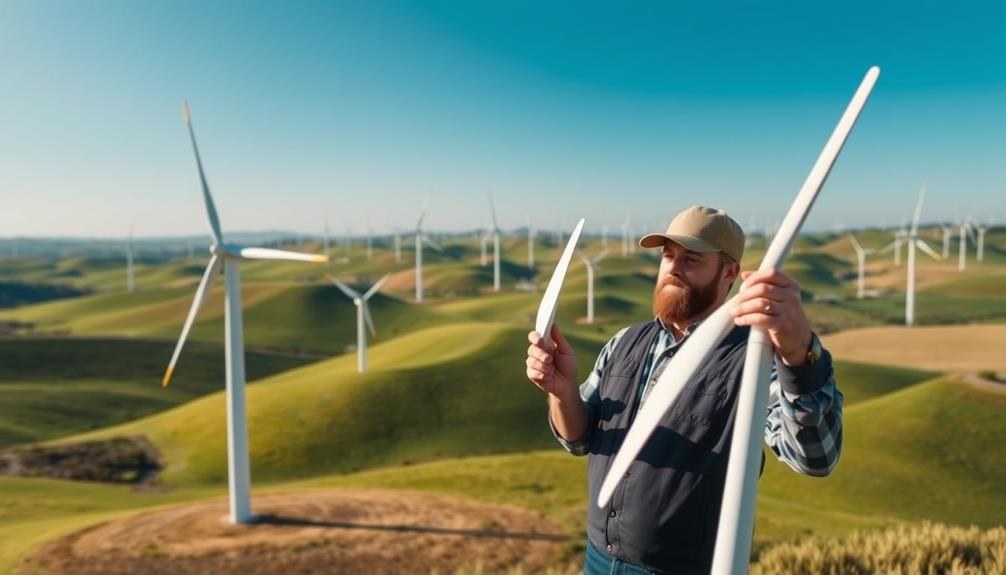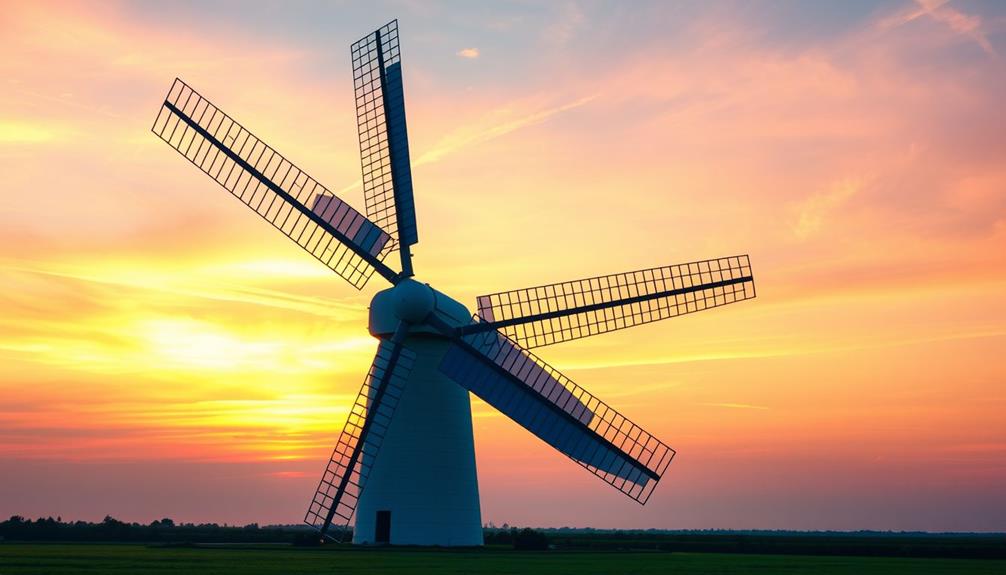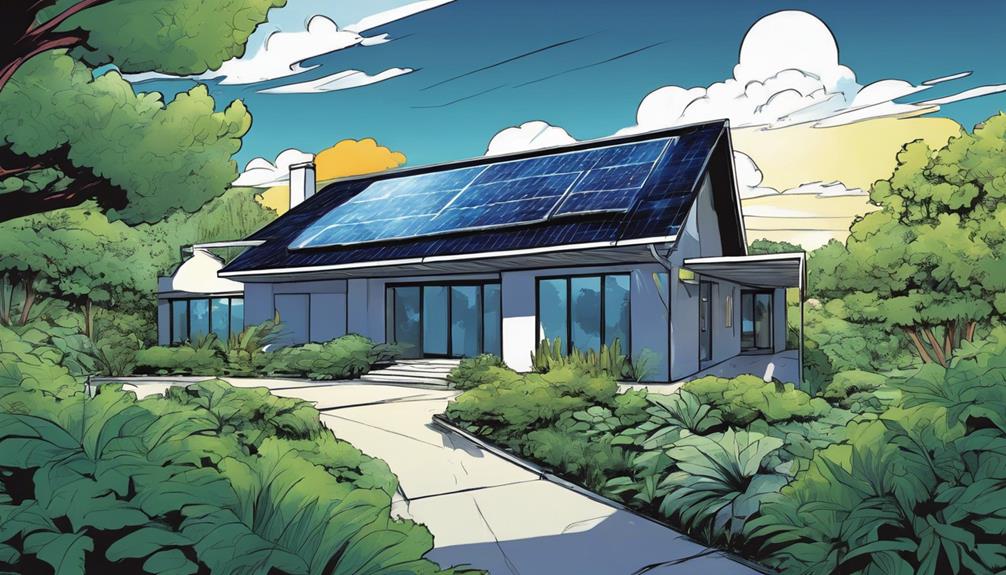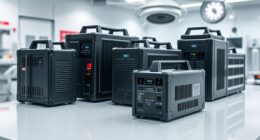Investing in wind turbines can be worthwhile, especially if you're looking to cut energy costs and boost your sustainability efforts. The initial setup might range from $15,000 to $4 million, depending on the turbine size. You could benefit from federal tax credits, which would help offset installation costs. While ongoing maintenance averages around $42,000 annually, the ROI usually spans 12 to 20 years. However, suitability of your site is critical, with factors like wind speed and location playing significant roles. There's a lot more to uncover about maximizing your investment; explore the details to make an informed choice.
Key Takeaways
- Wind turbine installation costs range from $15,000 to $4 million, with potential government tax credits of 30% to offset expenses.
- ROI for wind energy projects typically spans 12 to 20 years, influenced by site suitability and average wind speeds of 10-11 mph.
- Ongoing maintenance costs average $42,000 to $48,000 annually, increasing for aging turbines, impacting overall profitability.
- Combining wind and solar technologies can enhance energy generation and reduce reliance on a single energy source.
- Environmental and regulatory compliance is crucial for project approval and can affect public perception and long-term viability.
Understanding Wind Energy Costs

When considering wind energy, understanding the costs involved is essential for making informed decisions. The financial aspects of wind energy projects can vary considerably, especially when it comes to wind turbine costs.
For commercial wind turbines, you'll typically see prices ranging from $2.6 million to $4 million, or about $1.3 million per megawatt (MW) of capacity. Larger turbines, which can capture more wind energy, may come with a higher price tag but also greater potential for electricity production.
If you're looking at smaller wind turbines, installation costs range from $15,000 to $75,000 for systems between 5 to 15 kW, with federal tax credits of 30% to help ease those expenses. Understanding the weight of wind turbine blades can also influence the overall project costs, especially regarding transportation and installation logistics.
Maintenance costs also play a critical role in your overall investment. Ongoing operation and maintenance (O&M) expenses average between $42,000 and $48,000 per turbine annually, alongside an average of 1-2 cents per kilowatt-hour produced.
Thankfully, government incentives, like the Biden Administration's IRA, provide billions for green energy initiatives, which can greatly influence your project's financial viability. By understanding these costs, you can better assess whether investing in wind energy is a smart move for your energy needs and financial situation.
Evaluating Wind Turbine Capacity
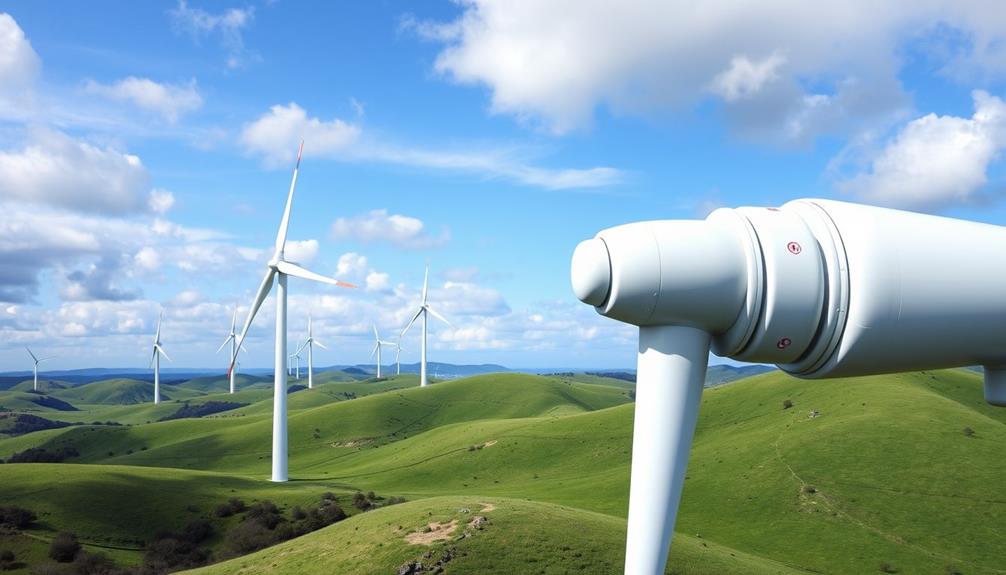
Evaluating wind turbine capacity is essential for maximizing energy production and guaranteeing your investment pays off. Wind turbine capacity, measured in megawatts (MW), indicates how much energy a turbine can generate under ideal conditions. For instance, a typical 2.5 MW turbine can power about 2,500 homes, emphasizing the importance of these ratings.
Additionally, understanding the efficiency of similar systems, like heat pumps, can provide insights into energy-saving features that may complement your wind energy investment, such as energy-efficient models.
You'll find that capacity factors vary considerably based on location; onshore turbines usually achieve 30-40% capacity, while offshore turbines can exceed 65%. This difference highlights how wind conditions affect energy production. For residential wind power, you need consistent average wind speeds above 10-11 mph to guarantee effective generation.
Consider advancements like the GE Haliade-X offshore turbine, boasting a capacity of 12 MW and long blades that enhance energy generation capabilities. Such innovations can greatly influence your investment's return.
Maintenance and Operational Expenses
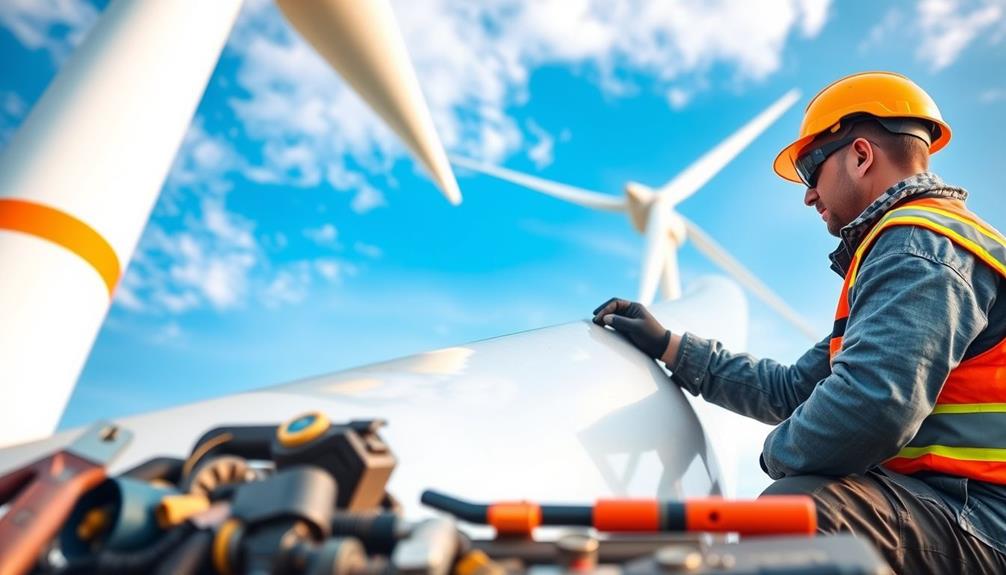
Maintaining wind turbines is vital for guaranteeing their efficiency and longevity, but it comes with ongoing operational expenses that can impact your bottom line. Typically, these expenses average between 1-2 cents per kilowatt-hour produced, resulting in about $42,000 to $48,000 annually for operation and maintenance (O&M).
Understanding the importance of a solid budget will aid in managing these costs effectively.
Here are some key factors to reflect on regarding maintenance and operational expenses:
- Aging Turbines: Older turbines usually incur higher maintenance costs due to increased wear and tear, leading to more frequent repairs and extended payback periods.
- Lightning Protection: Effective lightning protection systems are essential, especially offshore, as strikes can cause significant damage, adding to maintenance costs and downtime.
- Insurance and Land Rent: O&M expenses also encompass insurance, land rent, and administrative costs, contributing to your overall financial commitment.
- Technology Advancements: New technologies may help reduce maintenance challenges and lower operational costs over time, boosting the long-term viability of your wind turbine investment.
Understanding these elements will help you budget effectively and guarantee that your investment in wind turbines remains worthwhile.
Factors Impacting Investment Viability
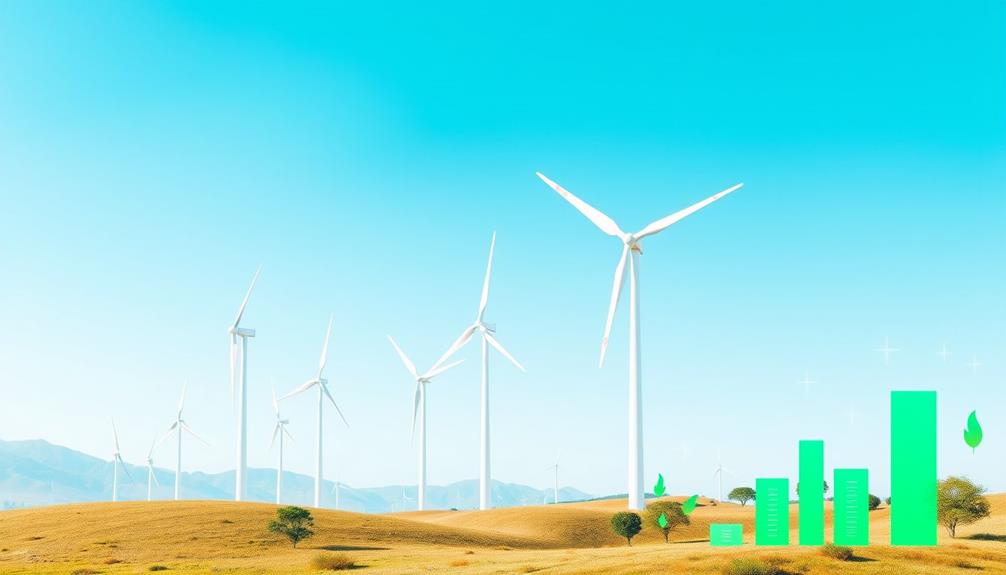
When considering wind turbine investments, you'll want to weigh the initial costs and financing options carefully.
Growing demand for transparency in private equity can also impact investor confidence in renewable energy projects.
Site suitability plays an essential role in determining your project's potential return, as does the ongoing maintenance and operational expenses.
Each of these factors can greatly influence the overall viability of your investment.
Cost and Financing Options
Investing in wind turbines involves a significant financial commitment, with commercial units typically costing between $2.6 million and $4 million. This translates to about $1.3 million per megawatt (MW) of capacity.
To navigate the costs and financing options effectively, consider the following factors: Additionally, understanding the potential for long-term capital appreciation in other investment areas can provide a broader perspective on the financial landscape.
- Initial Installation Costs: For small wind turbines, expect costs between $15,000 and $75,000 for systems ranging from 5 to 15 kW.
- Maintenance Costs: On average, you'll spend between $42,000 and $48,000 annually per turbine for upkeep.
- Federal Tax Credits: The Inflation Reduction Act of 2022 offers a 30% tax credit, helping to offset those initial installation expenses.
- Return on Investment (ROI): Wind energy projects generally see ROI between 12 to 20 years, influenced by energy production, maintenance, and site prep costs.
Site Suitability Considerations
How do you determine if a site is suitable for wind turbine installation? First, you need to assess wind speeds, as effective residential wind power generation requires an average speed above 10-11 mph (4.5-5 m/s). Sites in rural areas with minimal obstructions are ideal, as urban environments can drastically reduce energy output. Additionally, it's essential to guarantee that turbines are elevated at least 30 feet above nearby structures to avoid turbulence and maximize wind capture.
Here's a quick overview of key site suitability considerations:
| Factor | Importance |
|---|---|
| Wind Speeds | Requires 10-11 mph for viability |
| Rural Areas | Minimize obstructions for better performance |
| Zoning and Permitting | Varies by community; affects installation feasibility |
High electricity consumption in your home can further enhance the investment's viability, leading to greater returns through savings. By evaluating these factors, you can determine if your location is a sound choice for wind turbine installation, ultimately influencing the success of your energy investment.
Maintenance and Operational Expenses
Understanding maintenance and operational expenses is vital for evaluating the viability of your wind energy investment. These costs can greatly affect your project's profitability, especially as wind turbines age. Additionally, it's important to take into account the potential environmental impacts and regulations associated with wind energy, which may also influence operational costs.
Here are some key factors to keep in mind:
- Maintenance Costs: Typically, you'll face ongoing maintenance costs averaging 1-2 cents per kilowatt-hour, equating to $42,000 to $48,000 annually per turbine.
- Aging Turbines: As turbines age, maintenance costs can spike due to wear and tear, which can extend payback periods and impact overall investment viability. This is similar to the challenges faced in managing cold medications where understanding potential side effects is important.
- Lightning Protection: Implementing effective lightning protection systems, like StrikeTape, is important for offshore turbines. This minimizes maintenance costs and reduces downtime caused by lightning strikes.
- Operational Expenses: Beyond maintenance, take into account other expenses like insurance, land rent, and administrative tasks. These can greatly influence your financial outlook.
Technological advancements may offer some relief by reducing maintenance costs over time, enhancing long-term profitability. By understanding these factors, you can make a more informed decision about your wind energy investment.
Comparing Wind and Solar Energy

When considering renewable energy options for your home, comparing wind and solar energy reveals distinct advantages and challenges for each. Understanding these differences can help you make an informed decision.
| Feature | Solar Power | Wind Turbines |
|---|---|---|
| Installation Cost | ~$2.86 per watt (10 kW ~$27,300) | Starts at $30,000 for similar output |
| Maintenance Costs | Lower maintenance costs | Avg. $42,000 – $48,000 annually |
| Energy Generation | Depends on sunlight availability | Requires wind speed of 10-11 mph |
| Performance | Consistent in sunny areas | Highly variable based on wind speed |
For homeowners with high electricity demands, wind turbines could be beneficial if wind resources are adequate. However, they come with higher installation and maintenance costs. On the other hand, solar power installations are more commonly adopted due to their customizable nature and lower overall expenses. Additionally, combining both technologies can yield diversified energy generation, enhancing performance throughout different weather conditions. Ultimately, evaluating your specific situation will help you decide which option fits best for your needs.
Initial Purchase Considerations
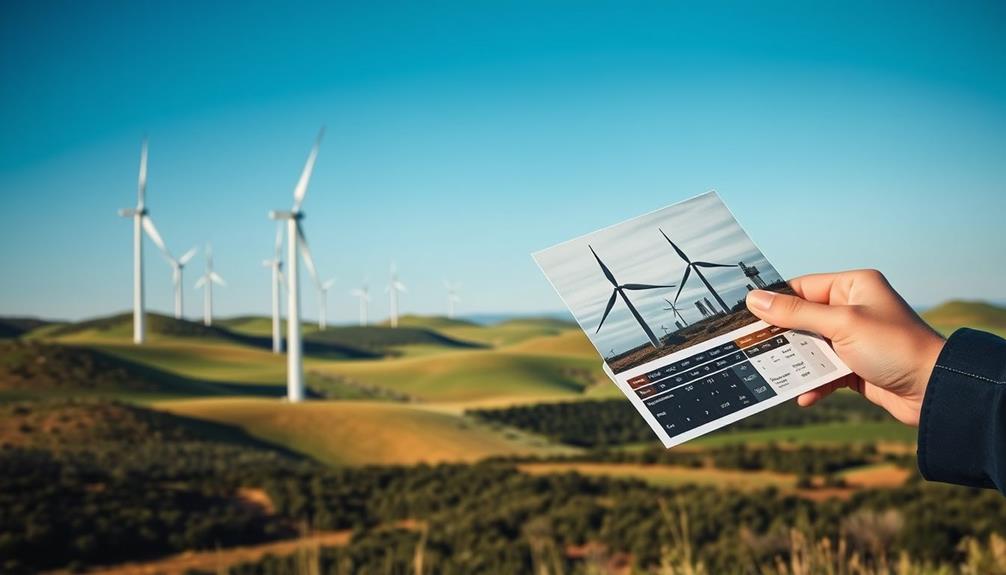
When you're considering purchasing a wind turbine, you'll need to factor in various costs, including the initial price and site preparation expenses.
The capacity of the turbine directly influences its price and potential return on investment, so it's essential to assess your energy needs.
Additionally, exploring investment strategies in precious metals can provide insights into diversifying your financial portfolio.
Cost Factors Explained
Purchasing wind turbines involves several cost factors that can particularly influence your investment. Understanding these elements is essential to make an informed decision. Here are the key cost factors to take into account: Additionally, reflecting on renewable energy options can be advantageous for reducing long-term costs and promoting sustainability, much like the benefits of aquatic exercise for physical health.
- Wind Turbine Cost per Megawatt: For commercial wind turbines, expect costs ranging from $2.6 million to $4 million, averaging about $1.3 million per megawatt (MW) of capacity.
- Installation Costs: Installation can greatly impact your budget. Factors like turbine height (80 to 150 meters) and rotor diameter (110 to 150 meters) contribute to the overall complexity and expense.
- Site Preparation: This aspect is often overlooked but can add considerable costs beyond the turbine purchase price. Ensuring the site is suitable may require additional investment.
- Small Wind Turbine Costs: For smaller installations (5 to 15 kW), costs can range from $15,000 to $75,000, depending on the system specifics.
Don't forget about potential maintenance costs and the importance of negotiated service agreements with manufacturers. These factors play a considerable role in the long-term success of your energy developments.
Capacity and ROI
Understanding the capacity of wind turbines is essential for evaluating your investment and potential return on investment (ROI). The capacity ratings, typically measured in megawatts (MW), directly influence both the cost and the energy production you can expect. For instance, a 2.5 MW rated turbine can generate 2.5 MW at peak capacity, which greatly impacts your ROI.
Additionally, similar to the competitive pricing found in precious metal investments, the cost of wind turbines can vary based on specifications and market demand.
When considering the initial purchase, you'll face costs ranging from $2.6 million to $4 million, averaging about $1.3 million per MW. However, remember that installation costs, including site preparation, aren't included in the purchase price, potentially increasing your total investment.
Additionally, the ROI for wind energy investments usually spans 12 to 20 years, depending on ongoing energy production and maintenance expenses. While volume discounts are rare due to the handcrafted nature of these turbines, knowing the costs and expected energy output can help you make an informed decision.
Ultimately, weighing these factors will guide you in determining whether investing in wind turbines aligns with your financial goals.
Long-term Financial Benefits

Investing in wind turbines can lead to notable long-term financial benefits. When you evaluate the overall investment, you'll find that the return on investment (ROI) period typically ranges from 12 to 20 years.
By taking advantage of federal tax credits of 30% under the Inflation Reduction Act of 2022, you can considerably reduce installation costs, enhancing the financial viability of your project. Additionally, as the demand for renewable energy sources continues to grow, the market for wind energy becomes increasingly attractive, creating opportunities for AI Cybersecurity Jobs to protect these assets.
Here are some key factors to evaluate:
- Maintenance Costs: Ongoing maintenance costs average between 1 to 2 cents per kilowatt-hour produced, totaling approximately $42,000 to $48,000 annually per turbine.
- Energy Production: Larger, more efficient turbines can achieve cost-effectiveness in energy production, needing fewer installations to be profitable.
- Selling Price: Wind-generated electricity has become increasingly competitive compared to traditional energy sources, improving your long-term financial outcomes.
- Payback: Turbines can pay for themselves through electricity sales to the grid, further enhancing your financial returns.
Assessing Site Suitability for Turbines
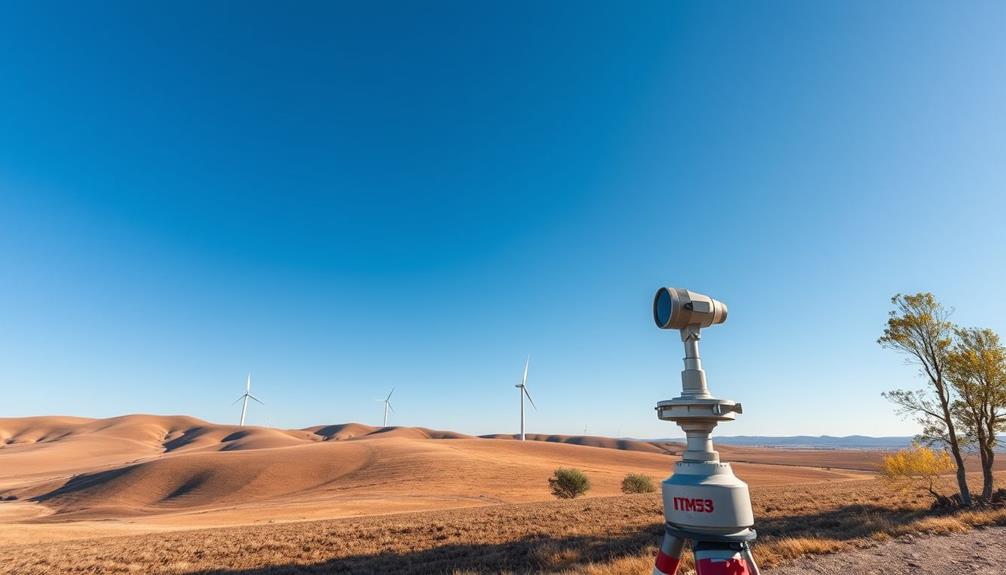
When it comes to evaluating site suitability for wind turbines, several key factors play an essential role in determining your project's success. You'll need to take into account the average wind speed, aiming for at least 10-11 mph (4.5-5 m/s) for ideal energy capture. Properties in rural areas with minimal obstructions are perfect, as nearby structures can considerably hinder turbine efficiency.
Installation height is another important aspect. Turbines should be at least 30 feet above surrounding structures, with many installations exceeding 100 feet for peak performance. Additionally, assess the permitting complexities that might arise, especially in densely populated areas, which can affect your timeline and feasibility.
Finally, don't forget to evaluate your energy needs alongside site suitability. High electricity consumption in your home enhances the viability of installing wind turbines, making this assessment essential.
| Key Factors | Importance |
|---|---|
| Average Wind Speed | Minimum 10-11 mph (4.5-5 m/s) |
| Site Location | Rural areas with few obstructions |
| Installation Height | At least 30 feet, ideally over 100 feet |
| Permitting Complexity | Varies by location |
Frequently Asked Questions
Are Wind Turbines Worth the Investment?
When considering if wind turbines are worth your investment, think about initial costs, potential ROI, and ongoing maintenance expenses. If you live in a windy area, they could considerably reduce your energy bills over time.
Are Home Wind Turbines Worth the Cost?
You might wonder if home wind turbines are worth the cost. With high installation expenses and variable energy output, you could save money, but only if conditions align perfectly. Are you ready to take that risk? In addition to the potential cost savings, a home wind turbine system can also provide a sense of independence and self-sufficiency by generating your own renewable energy. It can also contribute to reducing your carbon footprint and reliance on traditional energy sources. However, it’s important to carefully assess your location, wind patterns, and local regulations before investing in a home wind turbine system.
How Long Does It Take for a Wind Turbine to Pay for Itself?
It typically takes 12 to 20 years for a wind turbine to pay for itself, depending on installation costs and energy production. You'll see returns through electricity sales, but patience is key for long-term investment.
What Is the Return on Investment for Wind Turbines?
When you consider wind turbines, remember that ROI can range from 12 to 20 years. Sure, installation costs vary, but federal tax credits can offset expenses, making your investment more appealing in the long run.
Conclusion
Just like planting a seed in fertile soil, investing in wind turbines can yield fruitful rewards if you nurture the right conditions. As you weigh the costs and benefits, remember that the winds of change can either fill your sails or leave you adrift. By evaluating your site's suitability and understanding long-term gains, you can chart a course toward not just energy independence, but also a greener future. Your decision today could be the breeze that propels you forward.
